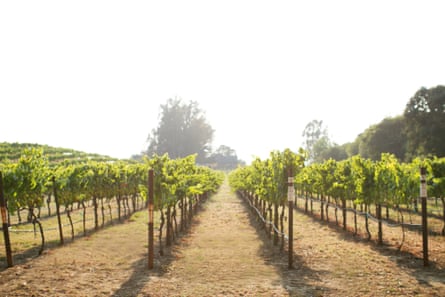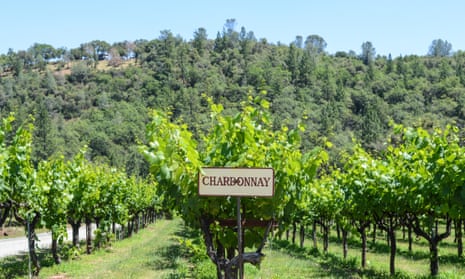On a recent Saturday evening at All Time, a flourishing neighbourhood restaurant in east Los Angeles, the waiter was advocating a particular white wine available by the glass.
“I’m not going to tell you what it is, because then you won’t want it,” he said as he poured. “Just try it.”
The wine in question was a chardonnay from Bret Brothers, which specialises in wines from the Mâcon region in southern Burgundy, where the vines grow on east-facing slopes in clay and limestone-rich soil. It was golden and crisp and tasted of stone fruit and flowers and, beneath that, something heavier and riper and more opulent. It was delicious. But it was also faintly surprising to find it there on the wine list at one of LA’s hippest young restaurants, alongside the menu offerings of Good Ass Salad, Mel’s Jalapeno Cornbread and A Whole Dang Branzino.
It is almost 25 years since chardonnay became unfashionable. In 1995, the New York Times reported on the ABC – Anything But Chardonnay movement. That same year, Alanis Morissette referenced the wine in her colossally successful song Ironic, and the Independent began running Bridget Jones’s Diary, a column that followed a thirtysomething woman as she steered her way uncertainly through London life, complete with career mishaps, dating catastrophes and a steadfast devotion to chardonnay.

The wine had been everywhere since the 1980s. In part, this was a result of the Judgment of Paris – the famed Paris Wine Tasting of 1976, at which a Californian chardonnay had triumphed over its French counterpart in a blind taste test. The surge of interest that followed meant that by 1988 there were more chardonnay vines planted in California than in France. It was also aided by the widespread introduction of varietal labelling (rather than labelling by brand or geography), which meant consumers were now able to ask specifically for “a glass of chardonnay”.
But such ubiquity took its toll. By 2001, the wine arguably reached its reputational nadir with the introduction of a character named Chardonnay to the cast of the trashy British TV series Footballers’ Wives. And in 2008, the retail analyst TNS reported that 200,000 fewer Britons had bought chardonnay in the previous 12 months. The wine critic Oz Clarke noted its decline, pointing the finger firmly at our favourite diarist: “Until Bridget Jones, chardonnay was really sexy,” he opined. “After, people said: ‘God, not in my bar.’”
Order a glass of dry white wine in a UK bar today and you will probably be served pinot grigio or sauvignon blanc. While Wine and Spirit Trade Association (WSTA) figures for supermarket white wine sales for the past 12 months show chardonnay stands in second place (behind sauvignon), totalling 82m bottles worth £421m, in pubs, bars and restaurants it languishes in third. And though there were 22.3m bottles of chardonnay sold in such establishments, at a cost of £331m, sales have fallen 16% over the past year. To soften this with a little context, UK white wine sales in general have fallen 10% over the same period, but chardonnay seems to be falling faster than most.
Chardonnay’s fall from grace had less to do with fictional diarists and Wags and considerably more to do with taste. To order “a glass of chardonnay” is perhaps to do a disservice to the exquisite diversity of this grape. The grape itself is a green-skinned blank slate, a neutral that will take on the flavours brought by terroir and oak barrels. In its native France, it is used in everything from champagne to gamay via white burgundy, Montrachet, Pouilly-Fuissé and more. It may taste of marzipan or hazelnuts, butter or liquorice. “It’s a grape that can parade different flavours, it can be oaky, it can have more of a flinty, chablis flavour,” says Lucy Panton from the WSTA. “There’s a different chardonnay for every palate.”

But, from the late 70s, the grape’s swell of success led to a generation of mass-produced, one-note New World wines that increasingly lacked the nuance of their Old World counterparts. “Between 1990 and 2005, US producers were chasing super-ripe styles, with horrendous levels of oak,” says Adam Lechmere, editor of British wine and spirits magazine Club Oenologique.
This in turn led In Pursuit of Balance (IPOB), a group of California wineries that came together in 2011 concerned that too many US wines – particularly chardonnays – were overripe, over-oaked and excessively alcoholic.
“In Pursuit of Balance really concentrated on pulling back from oak and making chardonnay a lean, stripped-down wine,” says Lechmere. “But then the pendulum swung back the other way and it became too lean.” He is all in favour of “acidity and lip-smacking steeliness”, he says, “but also chardonnay has to have fruit”.
IPOB disbanded in 2016, perhaps because it was no longer needed. Chardonnay has grown up – no longer swinging wilfully between extremes of oak and mineral, no longer mass-produced, boisterous slosh, but considered, cared-for, crafted – and is now being celebrated by a new generation of wine-lovers.
The appearance of the Bret Brothers chardonnay on the All Time wine list was the result of a trip to Burgundy that owners Ashley Ragovin and Tyler Wells made last July. “They are making pure, clean, beautiful, drinkable wines,” Ragovin says. “The purity and the focus and soulfulness expressed chardonnay at its truest.”

Among the chardonnays on the All Time list few, so far, have been Californian. “I think there’s more interesting things being done in California – zinfandel and carignan,” she adds. She would sooner choose something from France, Italy or, increasingly, Austria.
She rhaphsodises about the joys of an old world white burgundy. “It might sound antiquated, but it’s a beautiful, honest, expressive way of drinking chardonnay,” she says. “It’s still in the place where it sings, where it fulfills its chardonnay potential.” It is also, she argues, a world away from the chardonnays of yesteryear, “that oaky, heavy trend where they were trying to mimic what was seen as happening in Burgundy but without the history and the soil,” she says. “As if they thought ‘White burgundy! Let’s copy that!’ without any contextual understanding.”
Today, she has noticed an increasing number of customers willing to drink white wine, and while many still cling to their big-boned, old-school chardonnay, and still others recoil at the thought, she is finding a new openness. “There is a bracket that says: ‘I don’t drink chardonnay!’” she says. “I encounter that a lot at the restaurant. They’re hesitant to drink it. And then it surprises them. And that’s what I like.”
Could chardonnay see a similar reappraisal in the UK? For years now, there have been rumblings of a revival, although it has never quite come to pass and, as the figures show, sales are falling. But consider that when gin dropped out of the Office for National Statistics’ shopping basket, replaced by vodka, in 2004, it paved the way for the great craft gin revival we see today. Arguably, if the dreariness of chardonnay came in its mass-manufacturing and over-exposure, its rebirth might begin in its small, quiet reimagining.
When Club Oenologique launched recently, it used its first issue to reconsider chardonnay. “The reason we did that piece is because it’s safe to go back into the water again,” says Lechmere.
“We’ve just been a bit slower over here. But chardonnay’s time is coming.”

Comments (…)
Sign in or create your Guardian account to join the discussion